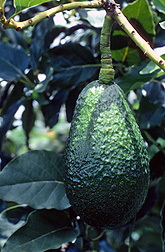Read the
magazine
story to find out more.
|

Genes are being sought to make Florida avocados
more resistant to Phytophthora root rot, which could become more of a
problem as Everglades restoration projects raise the water table. Photo
courtesy of Mark W. Skinner. USDA NRCS NPDC.
|

|
New Germplasm Could Help Protect Avocados from Root Rot
Disease
By Alfredo
Flores
August 1, 2008 New germplasm to broaden the genetic
diversity of avocados is being collected by Agricultural Research Service (ARS)
scientists and cooperators to help protect this popular fruit from a fungus
that damages avocado tree roots.
To help combat Phytophthora root rot (PRR), researchers at the ARS
National Germplasm
Repository in the Subtropical Horticultural Research Station in Miami are
screening the germplasm for markers for genes that might confer resistance to
PRR.
The research is led by plant geneticist
Ray
Schnell at the ARS Miami lab. Cooperators are molecular biologist James
Borrone (now at Oklahoma State
University), and colleagues at the University
of Florida (UF).
The avocado, a staple in the Mexican diet, is also very popular among U.S.
households—so much so that 43 percent buy avocados. The avocado tree,
native to the area from Mexico to northern South America, produces a fruit that
is unique and nutritious. Avocados contain 60 percent more potassium than
bananas, and are also rich in B vitamins and vitamins E and K.
The researchers are searching for ways to make avocado (Persea
americana) more resistant to PRR, which causes the roots of P.
americana to rot and, if untreated, to die. Excess water predisposes the
plants to PRR. This has not been a major problem in south Florida due to the
limestone soils and excellent drainage, but one of the major goals of the
Everglades restoration project is to raise the water table to restore the water
flow in Everglades National Park. This
will also increase the water table in the adjacent agricultural lands where
avocados are grown, potentially increasing the occurrence of PRR.
Using genetic sequence information, genetic markers (called microsatellites)
were developed. Genetic diversity in the collection of 224 accessions has been
studied using the genetic markers and, based on this study, researchers plan to
add new avocado types from the West Indies.
These molecular genetic markers will be useful for characterizing germplasm,
and for developing PRR-tolerant avocado rootstock.
Read
more about the research in the August 2008 issue of Agricultural
Research magazine.
ARS is a scientific research agency of the U.S. Department of Agriculture.